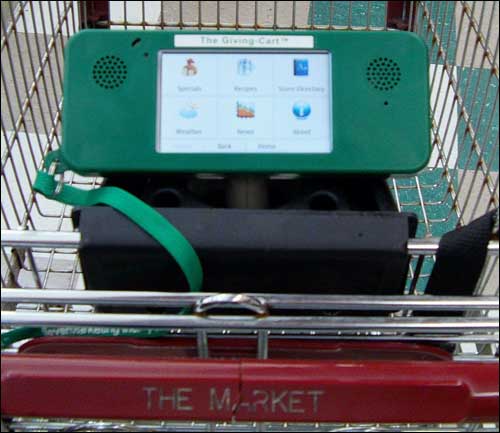Sep 25, 2009Shoppers at a supermarket in Park City, Utah, have begun carrying an RFID-enabled device that tracks their location and displays coupons, recipes and promotional videos based on their position within the store. The system, known as The Giving Cart, was developed by Time Domain and Klever Marketing, and is being deployed for the first time by The Market, an independent grocery store.
The store's owner, Mike Holm, hopes the system will improve customer allegiance, as well as provide him with information regarding shoppers' behavior, including where they spend more time, and how long they wait at the point of sale.

"The challenge to me was to have better communication with our customers and increase sales," Holm says. To that end, he met with Klever Marketing earlier this year, and was intrigued with The Giving Cart system.
The system consists of Time Domain's Precision Location Ultra Wideband System (PLUS) tracking system, using RFID chips, readers, antennas and Wi-Fi access points, as well as Klever Marketing's software for promotional materials and coupons. Klever also designed the Giving Cart mobile device, which has Time Domain's RFID chip built inside.
Since the day after Labor Day, greeters stationed at The Market's entranceway have been offering the mobile device to shoppers, explaining its benefits and how it can be used. Those who agree to try the device can either carry it by hand or attach it to a shopping cart. When not in use, the device is plugged in at a kiosk that recharges its battery.
The store, which measures 40,000 square feet, has approximately 44 RFID interrogators installed in the ceiling, along with their antennas, and is initially employing 50 mobile devices, according to Greg Clawson, Time Domain's senior VP of worldwide sales and marketing.
To add incentive to using the system, the store is also offering a "Chime Time Award," which enables random mobile devices to chime at certain times while the shoppers use the system. Those customers are then granted a reward, such as a cash reduction on the total purchase. When the patron goes to check out, she presents the device, which indicates which discounts and awards the clerk should apply. Once the customer pays for her purchase, the device is collected by a greeter or other employee, and is placed in the kiosk for recharging.
In the future, Clawson says, the system could also enable users to scan the bar code printed on the packaging of each product as it is placed in the shopping cart, thus creating a total purchase price when they arrive at the point of sale, which workers would then use to complete the check-out process more quickly.
The system will also enable stores to use the mobile units to display promotional materials for other local businesses—a restaurant in the same strip mall where the store is located, for example.
"The Giving Cart concept appealed to me immediately," Holm says, "because of the fact that I could give back to my customers with the Chime Time award program." Since installing the system, he adds, he has seen greater product sales, particularly in the private label brands featured in the coupon portion of the system. Neither Holm nor The Giving Cart's developers would reveal the costs The Market had incurred to install and operate the system.
The Giving Cart differs from other RFID-based shopping cart solutions, in that the RFID device is retrieved when a customer finishes shopping. This allows it to be recharged, while also preventing it from going out into the parking lot and being exposed to the weather, as well as getting lost. Because it is a handheld solution, Clawson adds, stores need not equip all of their shopping carts with RFID devices, since the carts are rarely all in use at any given time. Instead, stores can purchase a modest number of devices, and then invest in more as needed.

